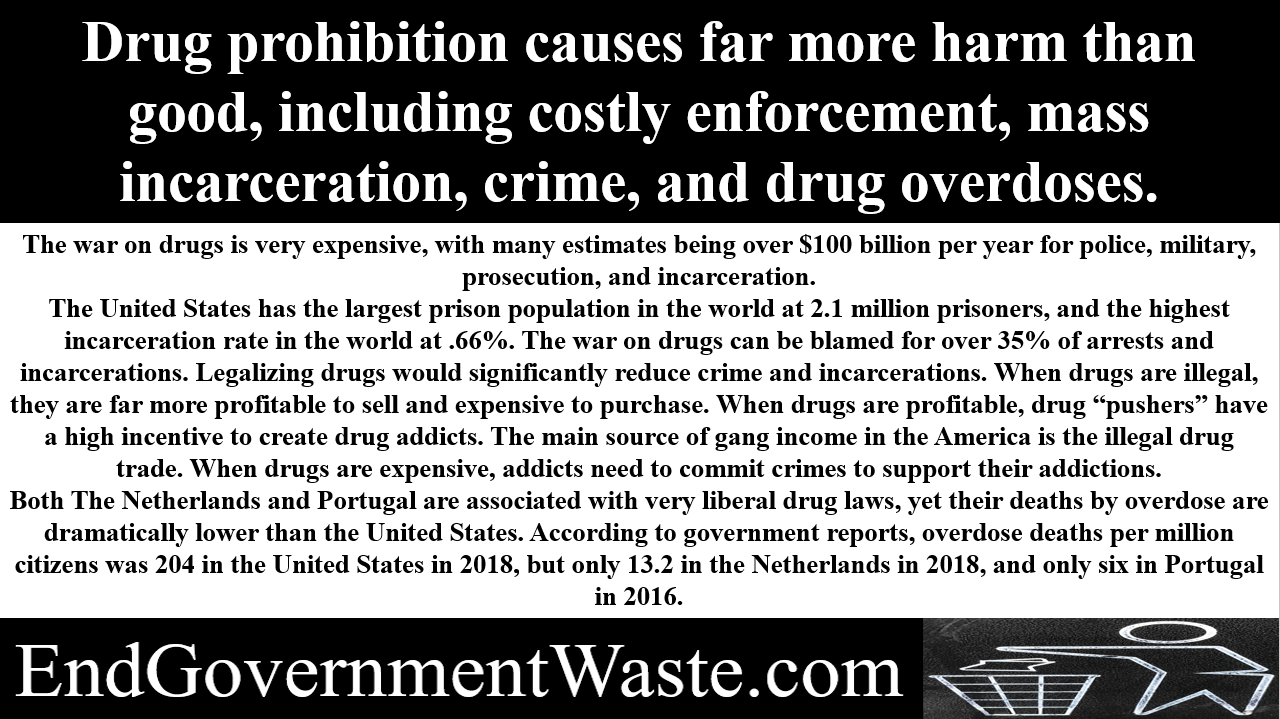

Drug prohibition causes far more harm than good, including costly enforcement, mass incarceration, crime, and drug overdoses.
Drug prohibition causes far more harm than good, including drug overdoses, crime, mass incarceration, gangs, costly enforcement, wasted resources, a reduction in individual freedom, and ruined lives. Supporting the legalization of drugs does not mean supporting drug use; rather, it focuses on the realization that our country’s “war on drugs” has failed.
Death from overdosing is far higher when a drug is illegal, because unregulated drugs result in impure drugs. Per the Centers for Disease Control, “Most recent cases of fentanyl-related harm, overdose and death in the U.S. are linked to illegally made fentanyl”. [1]
If drugs were legalized, regulated and distributed through doctors, drug users would receive regular counseling regarding the negative side effects of drug use, the interaction concerns with other drugs including alcohol, healthier alternatives, treatment and ways to quit. Illegal drug “pushers” don’t counsel addicts on how to quit and, because drugs are illegal, addicts are far less likely to seek help. We should be focusing on education and rehabilitation, rather than putting citizens in jail for victimless crimes.
For instance, both The Netherlands and Portugal are associated with very liberal drug laws, yet their deaths by overdose are dramatically lower than the United States. According to government reports, overdose deaths per million citizens was 204 in the United States in 2018, but only 13.2 in the Netherlands in 2018, and only six in Portugal in 2016.
Legalizing drugs would significantly reduce crime and incarcerations. When drugs are illegal, they are far more profitable to sell and expensive to purchase. When drugs are profitable, drug “pushers” have a high incentive to create drug addicts. When drugs are expensive, addicts need to commit crimes to support their addictions.
The United States has the largest prison population in the world at 2.1 million prisoners, and the highest incarceration rate in the world at .66%.[2] The war on drugs can be blamed for over 35% of arrests and incarcerations. According to drugpolicy.com, approximately 21% of prisoners are incarcerated for drug laws, mostly for drug possession. According to bjs.gov, surveys show that approximately 17% of inmates committed their main offense to obtain money for drugs, including 28% of property crimes and 10% of violent crimes.[3] Illegal drugs are the source of many violent crimes, not only due to drug users needing money to support their addiction, but also because drug dealers can’t seek legal action when there is a disagreement.
The main source of gang income in the United States is the illegal drug trade.[4] Gangs are responsible for a high percentage of homicides and deaths, accounting for approximately 50% of homicides in some big cities. In 2012, nearly 2,363 homicides, or 16% of homicides, were gang related.[5] According to nationalgangcenter.gov, “In a typical year in the so-called “gang capitals” of Chicago and Los Angeles, around half of all homicides are gang-related”. If the illegal drug money didn’t exist, the gangs would lose most of their power and allure.
In a country of scarce resources, every dollar we waste impacts our economy and reduces the standard of living for our society. The war on drugs is very expensive, with many estimates being over $100 billion per year for police, military, prosecution, and incarceration. The large prison population of 2.1 million people, along with the large number of arrests of over 10 million per year, are very costly. If the United States could reduce the number of arrests and incarcerations by 35%, it could likely save close to $35 billion per year and it could also stimulate the economy. Those in prison for drug related crimes lose $100 billion in wages and the country loses the productivity and wealth that those individuals could have contributed to society. Additionally, there would be far less need for prison guards, police officers and judges, and those individuals could be employed in productive jobs that provide a positive impact both to society and to the economy.
In a free country, why is the government throwing millions of individuals in cages for the victimless “crimes” of using drugs? Why does the government choose to arbitrarily tell citizens that they cannot do something that does not hurt others? Should the government arrest obese individuals because they are hurting themselves? Ironically, the “good intention” of saving drug users from themselves by putting them in jail rather than providing safe alternatives and treatment, actually ruins their lives and the lives of their families. Consider the financial impact on the incarcerated individual and their family due to lack of current income and reduced future job prospects and reduced future income. Further, the war on drugs is actually creating criminals. The reduced job prospects and income, while incarcerated and afterward, make it more likely that the incarcerated individual will commit non-drug crimes in the future.
Polls show that the public overwhelmingly believes that the war on drugs is being lost and that treatment is better than incarceration. While it would be optimal to eliminate drugs without unintended consequences, it is not realistic. And making drugs illegal, as with the prohibition of alcohol, has failed.
[1] Centers for Disease Control: Fentanyl (2020, March 19). Retrieved from: https://www.cdc.gov/drugoverdose/opioids/fentanyl.html
[2] Wikipedia: List of countries by incarceration rate. (2020, December 3). Retrieved from:
https://en.wikipedia.org/wiki/List_of_countries_by_incarceration_rate
[3] Bureau of Justice Statistics: Drug and Crime Facts. (2020, December 7). Retrieved from: https://www.bjs.gov/content/dcf/duc.cfm
[4] United State Department of Justice: Attorney General’s Report to Congress on the Growth of Violent Street Gangs in Suburban Areas. (2008, April). Retrieved from: https://www.justice.gov/archive/ndic/pubs27/27612/index.htm
[5] Office of Juvenile Justice and Delinquency Prevention: Highlights of the 2012 National Youth Gang Survey. (2014, December). Retrieved from: https://ojjdp.ojp.gov/sites/g/files/xyckuh176/files/pubs/248025.pdf
